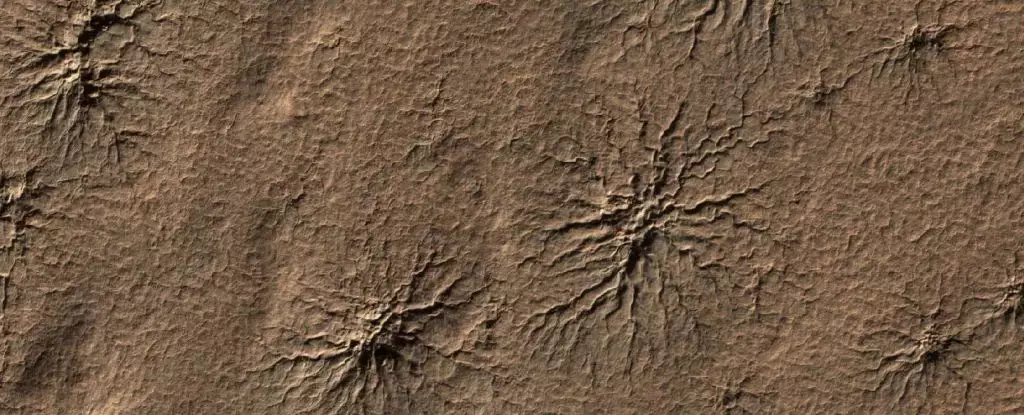Mars, often referred to as the Red Planet, holds many secrets beneath its ochre-colored surface. Among the most intriguing spectacles are formations reminiscent of spiders, which grace satellite imagery of the Martian landscape. Dubbed “araneiforms,” these dark, tendrilled structures are not biological organisms but rather fascinating geologic features shaped by unique climatic conditions. They manifest solely in the southern polar region during Martian spring, sparking curiosity across the scientific community. Despite their peculiar resemblance to arachnids, these formations offer critical insights into Mars’s environmental dynamics and the processes that sculpt its surface.
The prevalence of araneiforms only in the southern hemisphere during a particular season raises questions concerning their origin and formation. While the mere sight of these structures is mesmerizing, deciphering the mechanisms behind their emergence is a scientific puzzle that has occupied researchers for years. This ongoing investigation aims to enhance our understanding of Martian geology and the broader principles governing planetary science.
The origins of araneiforms have long been attributed to a phenomenon involving carbon dioxide—specifically its phase transition from solid to gaseous state. The Kieffer model, named after geophysicist Hugh Kieffer, articulates this transformation process. It asserts that during the frigid Martian winters, carbon dioxide freezes onto the surface of the planet, creating layers of ice. As springtime arrives, rising temperatures cause the frozen carbon dioxide to sublimate, transitioning directly from solid to gas.
However, the process does not operate uniformly. Unlike Earth, where liquid carbon dioxide can exist under specific circumstances, Martian atmospheric conditions lead to a buildup of gaseous pressure beneath ice layers. The darker regolith beneath these ice deposits absorbs solar heat, causing localized warming and trapping that sublimated gas. As pressure accumulates and exceeds the structural integrity of the icy layers, the gas creates fissures and results in violent explosions. These explosive events launch the gas, along with dust, upward and outward, ultimately leaving a characteristic spider-like scar in their wake.
Experimental Endeavors: Mimicking Martian Conditions
To delve deeper into the enigmatic formation of araneiforms, scientists employed an innovative experimental setup. Utilizing a chamber called the Dirty Under-vacuum Simulation Testbed for Icy Environments (DUSTIE), researchers sought to recreate Martian conditions, both in temperature and atmospheric pressure. This meticulously designed apparatus allowed experimentation under conditions analogous to those found on Mars.
In their laboratory work, scientists utilized a simulant of Martian regolith—an amalgamation of minerals carefully selected to approximate the composition of Martian soil. Following rapid cooling in liquid nitrogen, they introduced carbon dioxide into DUSTIE, where it subsequently froze onto the simulant. As the team maneuvered through various experimental cycles, they incrementally increased the temperature, leading to crucial observations. Upon reaching critical conditions, the buildup of gas caused a mini-explosion, resulting in the creation of araneiform-like patterns.
What emerged was a revelation: Contrary to initial expectations, ice did not form atop the regolith but instead developed within it. This alteration in understanding underscores the complexity of Martian geology and suggests that explosive events can lead to distinctive surface patterns originating from deeper beneath the surface.
The insights gained from these experimental endeavors profoundly influence our comprehension of the Martian surface, shining light on not only the formation of araneiforms but also broader seasonal phenomena on the planet. As the Kieffer model proved to be a foundational framework for these processes, researchers are optimistic about refining these models further through continued experimentation.
Investigating these features has implications that extend beyond academic curiosity. Understanding Martian geology is pivotal as humanity prepares for potential exploration or even colonization of the planet. The information gleaned from the study of araneiforms may inform the design of future missions, aid in habitat selection, or even detect environmental hazards.
As we progress in these explorations, the wonders of Mars continue to unfold. Each layer of understanding builds upon the last, revealing an extraordinary narrative that connects planetary processes to the enigmas of our universe. Whether through the lens of satellite imagery or the reflections from laboratory experiments, the quest to uncover the red planet’s secrets will persist, leading us deeper into the cosmos.


Leave a Reply